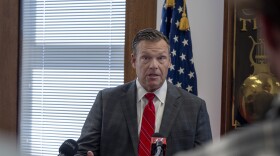Congressional testimony began Thursday on a bill that would create a federal commission to look into the impacts of Native American boarding schools such as those that once operated throughout Kansas and at two sites in Missouri.
The bill, sponsored by U.S. Democratic Rep. Sharice Davids, of Kansas, could also impact ongoing efforts to identify unmarked gravesites at religiously affiliated schools like the Shawnee Indian Mission in what is now Fairway, Kansas.
“In many ways, that school, which still stands today, is a memorial to the struggles and perseverance of the Shawnee people,” Shawnee Chief Ben Barnes told members of the House Subcommittee for Indigenous Peoples. “But like other sites, its history remains incomplete.”
Barnes and the Shawnee Tribe have been calling for a deeper look at the former boarding school since last summer. Children from the tribe were sent to the mission in the mid-1800s, and they faced abuse, neglect and harsh living conditions.
“We can still see carvings left in the windowless attics where children were forced to sleep in hot summers and cold winters,” Barnes said.
Witnesses also detailed instances of sexual, mental and physical abuse at boarding schools across the country.
If passed, the bill would establish a federal commission to locate and analyze records from more than 360 of the country’s known Native boarding schools. Advocates and Native leaders told members of the subcommittee those records are notoriously hard to acquire, if they exist at all.
As written, Davids’ legislation would give the investigative commission congressional subpoena power.
“In large part, we don’t know the stories of the children that went there,” Barnes said, “including the names of those that died and the locations of their burial sites.”

In October, Barnes announced a partnership with the city of Fairway to investigate the history of the Shawnee Indian Mission, and called for the federal government to do more research into Native boarding schools.
“If Native children were able to endure and survive the Indian boarding school era in our nation, we should be able to find it in ourselves to fully investigate what happened to our relatives and work toward a brighter path for the next seven generations,” Davids said in opening remarks.
Davids, a member of the Ho-Chunk Nation of Wisconsin, told the subcommittee that two of her grandparents were boarding school survivors.
A day earlier, the U.S. Interior Department released its first-ever inventory of Native boarding schools, which included two schools in Missouri and 12 in Kansas.
The report is one of the first steps of the Interior Department’s Indian Boarding School Initiative, which was announced in June 2021 to help inventory the country’s boarding schools and their related burial sites, and address the intergenerational trauma they inflicted on Native families.
Witnesses Thursday said they see the Interior Department initiative as separate from Davids’ proposed commission but equally important.
“It is my priority to not only give voice to the survivors and descendants of federal Indian boarding school policies, but also to address the lasting legacies of these policies so Indigenous peoples can continue to grow and heal,” Interior Sec. Deb Haaland, the first Native American woman to lead the department, said in a press release. The Interior Department oversaw the country’s once-vast network of boarding schools.
The department found that hundreds of Native children died in the boarding school system, and it identified 53 burial sites for children at 19 sites across the country. Both figures are expected to rise as research continues.
The agency's report describes the schools’ goals as “cultural assimilation and territorial dispossession of Indigenous peoples through the forced removal and relocation of their children.”
The report cites two Kansas boarding schools specifically, referring to efforts at Haskell Institute in Lawrence to keep students from using their Native languages and the practice at the Kickapoo Boarding School in Horton of “soundly and prayerfully” whipping students who attempted to run away.

The report did not include details about the location of gravesites “in order to protect against well-documented grave-robbing, vandalism and other disturbances to Indian burial sites.”
Also included on the list of more than 400 schools were religiously affiliated institutions like the Shawnee Indian Mission, because they offered student housing and education prior to 1969, and because they received federal funding or support.
As part of the Federal Indian Boarding School Initiative, Haaland will also conduct a year-long tour across the country to hear the stories of boarding school survivors and help connect communities to support services.
Copyright 2022 KCUR 89.3. To see more, visit KCUR 89.3. 9(MDA4OTAxNzAzMDEzMjc0MTc2MzA5ZDZlMw004))







